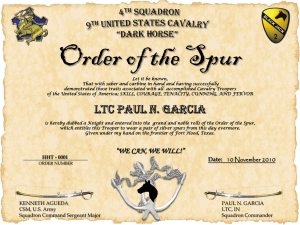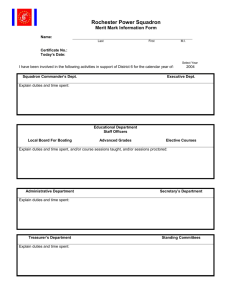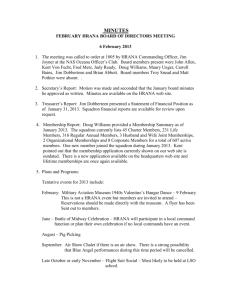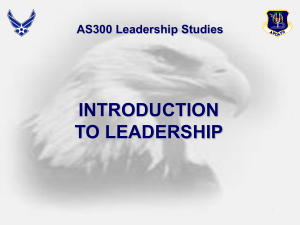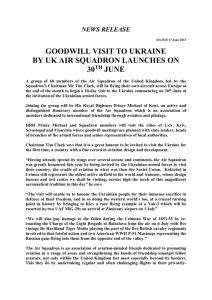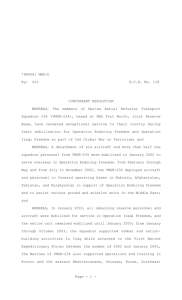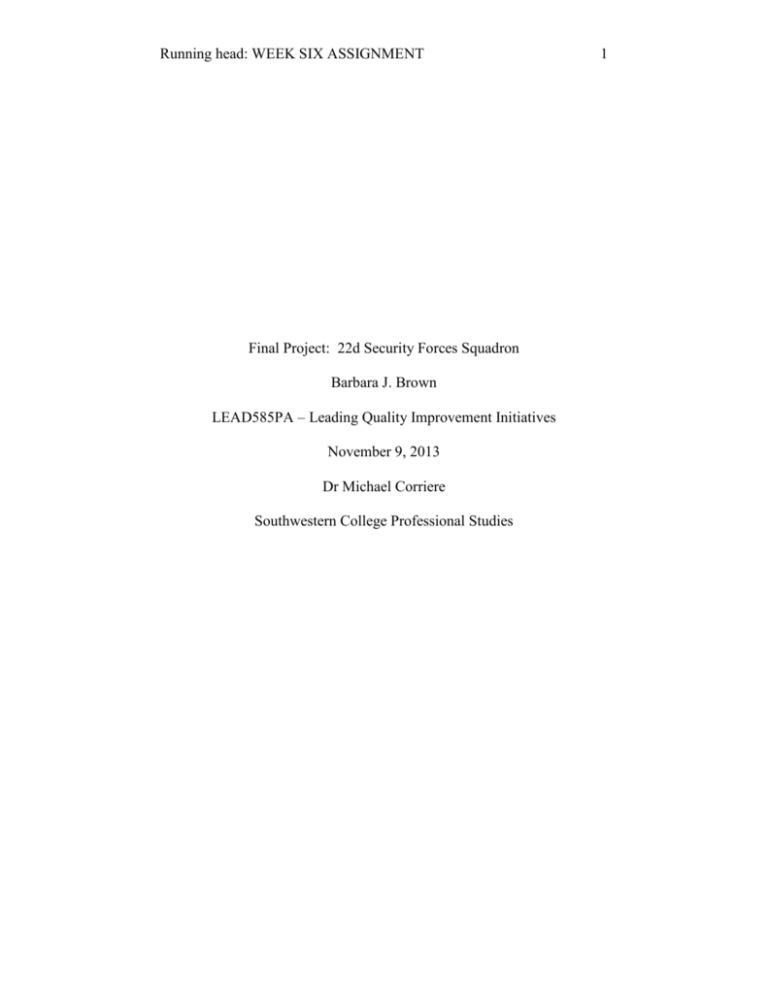
Running head: WEEK SIX ASSIGNMENT
Final Project: 22d Security Forces Squadron
Barbara J. Brown
LEAD585PA – Leading Quality Improvement Initiatives
November 9, 2013
Dr Michael Corriere
Southwestern College Professional Studies
1
WEEK SIX ASSIGNMENT
2
Final Project: 22d Security Forces Squadron
Executive Summary
The Department of Defense (DoD) is achieving significant performance improvements in its
full range of activities, from operations to human resources management and logistics
management with major focus on improving the support for the warfighter customer by applying
Continuous Process Improvement (CPI) concepts and tools (Sicilia, 2008, pg. 1-1). As a DoD
component, the 22d Security Forces Squadron strives to meet is organizational commitments by
the most efficient and effective means possible. The purpose of this report is to discuss the 22d
Security Forces Squadron and assess the organization’s ability to produce strong and sustainable
results through balanced performance improvements using the Malcolm Baldrige Quality Award
criteria in seven categories. Research for this report includes the assigned readings from the
course textbook, 24 years of military experience, and additional outside research. The major
findings indicate effective control and measurement systems, use of knowledge management and
lessons learned, continual opportunities for personal and professional growth, and history of
successful organizational improvement. Before we can discuss their sustainable improvement
efforts, we must first begin by discussing the organizational framework and background of the
22d Security Forces Squadron.
Organizational Framework
The framework of the 22d Security Forces Squadron is based on three operational levels. At
the top of the tier is the 22d Air Refueling Wing whose mission is to deliver total force mission
ready Airmen and KC-135 Stratotanker mobility to combatant commanders through robust
installation support anytime, anywhere (AF Portal, 2013). This organization operates at a
WEEK SIX ASSIGNMENT
3
strategic level by planning the support of missions of the lower tiers. The wing is comprised of
5,671 active duty military and civilian personnel.
The middle tier is the 22d Mission Support Group who is charged with providing leadership
and management for all mission support services including security, fire protection, contracting,
transportation/supply and fuels, food, lodging, housing, communications, personnel, recreation
and facilities management (AF Portal, 2013). This organization operates as an operational level
by working with seven squadrons to provide support services to active duty, civilian, and retiree
personnel. The group is comprised of 1,400 active duty military and civilians personnel.
The lower tier is the 22d Security Forces Squadron which is charged with providing a safe
and secure environment at home and abroad by training, equipping, protecting, and developing
security forces airmen and leaders to meet current and future challenges. This organization
operates at the tactical level by providing protection of operational forces, training and
maintenance of small arms and light weapons, military working dog capability, and protection of
nuclear assets. The squadron is comprised of 230 active duty military and civilian personnel.
All three tiers work together to ensure safe and sure mission accomplishment, increase
installation efficiency and savings, enhance mobility partnerships, and improve mission
sustainment. Each tier receives direction from the tier above it.
Organizational Profile
The 22d Security Forces Squadron mission is to “provide a safe and secure environment at
home and abroad” and vision of “unparalleled force protection through integrated base defense at
home and abroad” (Lacek, 2013). The culture of the organization is the Air Force Core Values
of “service before self”, “integrity first”, and “excellence in all we do” as well as its customs and
courtesies. The structure is setup to integrate the efforts of personnel at all levels. It is
WEEK SIX ASSIGNMENT
4
comprised of five sections, each with its own distinct function that supports each of the others. It
provides police services and physical security of 3.6 billion dollars in assets and protection of 53
alarmed facilities. It also supports the base populace with combat arms training and The Boeing
Company with on-call military working dog bomb detection capabilities. The organization’s
priorities are aligned with its goals and objectives. Challenges faced include continuity,
resources management, training, personnel development, and communication.
Focus on Effectiveness and Efficiency
The Department of Defense (DoD) and the 22d Security Forces Squadron strive to
successfully make continuous process improvements. Department of Defense Directive 5010.42
establishes policy and assign responsibilities to institutionalize Continuous Process Improvement
(CPI) /Lean Six Sigma (LSS) as one of the primary approaches to assessing and improving the
efficiency and effectiveness of DoD processes in support of the Department’s national defense
mission (England, 2008, pg. 1). Organizations are to implement CPI/LSS programs to improve
overall effectiveness and efficiency across missions and functions to gain the broadest possible
range of organizational improvements (England, 2008, pg. 2). The forthcoming Malcolm
Baldrige National Quality Award criteria is a valuable tool to help the organization plan,
perform, and measure results in a “Quest for Excellence.” The following is my assessment of the
22d Security Forces Squadron in the seven graded award criteria areas.
Category 1 - Leadership
Senior leaders in the organization set the organizational focus and I believe the organization
places extreme value on leadership. Leaders are clearly expected to lead the workforce toward
the good of the organization always being cognizant of data driven value decisions. They
encourage bottom-up ideas with guiding and coaching. The layers are associated with the rank
WEEK SIX ASSIGNMENT
5
of employees. Consequently, solid leadership is important at all levels because there are
followers at each level. Managers and leaders are setting daily examples of how they expect
their employees to perform. Senior leaders also share the organizational vision and performance
objectives with their employees through communication and the Squadron Sight Picture located
on page 7. Vision and mission are aligned with that of its employees to ensure everyone is
working together for accomplishment.
Majority of organizational leaders are involved with their employees and succeed at creating
an environment for performance improvement, innovation, and open communication. Senior
leaders communicate with the entire workforce whenever possible. This is achieved with police
officers’ post visits, weekly safety briefings, monthly staff meetings, quarterly commander’s
calls, and numerous organizational morale events. The squadron commander employs an
“intrusive” style of leadership. The organization is 100 percent responsible for all of its
members which is a very different culture than a civilian business. “Intrusive” meaning
supervisors must know their people, ask the hard questions, and make the hard decisions.
Supervisors must know what their personnel are doing on their day off and how they live which
can help with providing the necessary assistance to them before their small problems become
bigger ones. “Intrusive” leadership = caring about your airmen.
Category 2 - Strategic Planning
An organization that does attempt to plan its future may not have a successful future.
Strategic planning includes the process of establishing and clarifying purpose, deciding on the
objectives whose attainment will help fulfill purposes, and determining the major means and
“pathways” (strategies) through which these objectives will be pursued (Anderson, 2012, pg.
276). The strategy development process for the organization is based on related goals. Some
WEEK SIX ASSIGNMENT
6
goals are dispensed down to the organization through its hierarchy and some are developed at the
organizational level. Senior leaders get together and review the key elements and processes of
the organization. Goals and strategic objectives are established based on the requirements for
each. For example, the organization’s administrative office is required to ensure employee
appraisals are conducted annually and turned into the personnel office no later than 30 days after
they close out. The senior leaders established a goal the appraisals will be turned in no later than
five days after closing out. As a result, each section adjusted their processes to meet the refined
objective. This process allows the organization to adjust to unpredictable events and still meet
the personnel office objectives. The organization develops monthly strategies and performance
measures as well as long range strategies. The planning starts with a goal and continues on a
roadmap of desired outcomes, strategies, measurements, and projected results of meeting the
goal. The following chart is the monthly organizational Sight Picture for October 2013.
WEEK SIX ASSIGNMENT
7
Category 3 - Customer and Market Focus
The organization has both internal and external customers. Internal customers are
organizational employees and external customers are the base populace to include military,
civilians, retirees, contractors, and base visitors. Internal and external feedback is obtained
through verbal communications, the squadron’s Facebook page, surveys, electronic and paper
communications, and employee performance feedback. Additionally, the organization often
provides military working dog and vehicle demonstrations as well as weapons displays for local
community events and schools. This not only helps to foster community ties but also provides
an outlet for obtaining off-base feedback. Most external feedback is documented and kept with
the organization’s Report and Analysis section. Unsatisfactory feedback is investigated and
analyzed for areas of process improvement. Senior leaders follow up with the customers to
ensure immediate and actionable feedback is given.
The organization is always trying to find new strategies, technologies, and processes that
produce improvements. To capture external feedback and ideas, several base entry control
stations distribute customer service questionnaires to base customers. Internal feedback is also
collected on the squadron SharePoint site where employees can go to request changes or provide
ideas for improvement. Internal customer service survey results are assessed. Something as
simple as conducting a small scale research and survey plan can foster significant improvements.
Recently surveys were conducted to gather the perceptions and opinions of the Visitor Center
customers on a variety of topical areas. Inputs were welcomed and changes were implemented
which resulted in more satisfied customers. These organizational efforts help to build
relationships and grow customer satisfaction.
WEEK SIX ASSIGNMENT
8
Category 4 - Measurement, Analysis, and Knowledge Management
An important factor and driving force in any business is its goals because they help an
organization measure their effectiveness. Goals and objectives provide the organization with a
blueprint that determines a course of action and aids them in preparing for future changes. This
organization has goals set for each essential process which are reviewed and assessed quarterly.
With each goal there is an objective and measurable results. Goals that are not being met are
evaluated. Those processes are reviewed and adjusted to improve probability of future goal
achievement. This course of action helps to improve organizational performance.
Additionally, the organization conducts annual unit climate assessments (UCA) to measure
how the organization is doing through the opinions of all ranks of employees. These assessments
are a website survey and anonymous so members can be brutally honest. Survey participation is
tracked and encouraged. The survey results are reported to the commander the following week.
A formal briefing is given by the Military Equal Opportunity office and the squadron
commander briefs the areas of concern to the entire squadron. Problem areas are investigated
and results documented. The UCAs are kept on file indefinitely for trends and future reference.
The organizational also conducts internal and external inspections to assess their
performance capabilities. Next week the base is conducting a Disease Containment exercise to
test their ability to work as a team and with outside local agencies should an actual disease
outbreak occur. Earlier this month, the organization conducted a nuclear response exercise to
test their ability to respond to a nuclear threat. All positive and negative exercise results are
documented, corrective actions taken, and a collection of lessons learned are provided to the
squadron historian for future knowledge sharing.
WEEK SIX ASSIGNMENT
9
The Air Force definition of knowledge management is “the strategies and processes of
identifying, capturing and leveraging knowledge and expertise within an organization” (AFSO
21, 2007). I believe the organization does an adequate job of knowledge sharing, however there
is room for improvement. Continuity is a challenge for a military organization. Information is
lost if it is not documented and shared with current and future workers. During the recent
government furlough, some internal processes stopped because civilian employees were not at
work. The organization failed in some areas to ensure there were backup plans and continuity
books in place so other employees could pick up where the departed employees left off. The
organization utilizes SharePoint, the Air Force Portal, and databases to accelerate knowledgesharing and replication of best practices.
Category 5 - Workforce Focus
Employee development and leadership enhancement is extremely important to the
organization. Both help the workforce achieve organizational and personal success. Leaders at
all levels encourage their employees to take advantage of every educational opportunity even if it
not required for their current job. Leaders help determine employee training and developments
needs by conducting surveys, face-to-face communication, or analyzing performance trends.
Development and skill enhancement is accomplished through skill level progression. Each skill
level requires job specific training through mandatory training guides and on the job training.
There is also a requirement to pass a course examination before award of the next skill level.
This is accomplished by tiers of mandatory training based on current rank.
Additionally, off-duty education is highly encouraged. Some military courses are awarded
college credit and each employee is encouraged to attend college courses and obtain a total of 64
college credit hours for award of a Community College of the Air Force associates degree. This
WEEK SIX ASSIGNMENT
10
allows the member to increase their job knowledge while also completing a degree plan. As a
result, it builds an effective and supportive work environment and helps the organization be
successful.
The squadron also designates one day a week as a “training day” to allow squadron members
the opportunity to focus on training and learning new techniques. Police officers have to be
proficient and up-to-date on any activity involving their job. Proficiency training like weapons
qualification and active shooter scenario training are provided. Law enforcement is a stressful
job and to help balance life, family, and police duties, one day a year the squadron stands down
and conducts 8 hours of Resiliency Day training.
The organization offers many volunteer opportunities and supports getting involved in the
community. Every year they provide tremendous support to the local law enforcement by
participating in the local Law Enforcement Memorial ceremony. They also support the Special
Olympics Torch Run also sponsored by local law enforcement. All of this builds ties with the
local community and helps to foster a well-rounded force.
Civilian employees are included in the supportive work environment. Civilian continuity is a
significant strength for the organization. Of a 240 squadron members, 37 are civilian employees.
There are approximately sixteen civilian police officers and four of the five sections are led by a
civilian employee. Each of these positions provides immense continuity. Military personnel are
continually deploying, separating from the Air Force, or moving on orders to another duty
station. Civilian employees assist with the workload when manning positions are not filled and
when military members take leave.
WEEK SIX ASSIGNMENT
11
Category 6 - Operational Focus
The squadron’s main mission is the protection and security of the base and its inhabitants.
Therefore, it is continually searching for ways to increase its organizational effectiveness by
utilizing surveys, trends and analysis, and inspections performed by internal and external
agencies. It also utilizes technology to help decrease security violations. Recently the
organization initiated the procurement of the License Plate Recognition system. This system
takes a picture of each car license plate as it arrives at the entry point and checks if there are
warrants or major violations assigned to the vehicle owner. If there are, the system sends a
message to the entry controller. As a result of the system, approximately 10 arrests have been
made.
The organization also utilizes excellent resource management to improve its organizational
work processes. Military vehicle abuse trends are analyzed and violators are reprimanded.
Accidents on base are noted and if trends occur, action is taken. For example, there was a trend
in base housing of children on bikes being hit by vehicles. As a result, the speed limit was
reduced to 20 miles per hour decreasing accident rates by 24 percent. Additionally, office
supplies are stockpiled in the Supply section for a single supply point. This saved the
organization money by reducing purchases for items that other sections had on hand and were
not using.
Additionally, the organization strives to eliminate wastes or inefficiencies. The base Visitor
Center conducted a statistical analysis of their weekend workload. After pulling data from their
visitor tracking system, it was determined they had 10-13 visitors on the weekend for an entire
month total. The center had been open on the weekends for at least 10 years with two employees
per shift, per day. The base entry controller has the capability to write visitor passes quickly but
WEEK SIX ASSIGNMENT
12
was never utilized to that point. After the data was analyzed and verified, the visitor center is
now closed on the weekends saving $18,000 per year in employee pay.
Category 7 - Results
The organization’s product and service performance results are excellent. All five
organizational sections work together to provide police services and physical security for $6.1
billion in assets and the safety of 13,000 active duty, civilians, contractors, retirees, and base
visitors. The organization’s customer-focuses performance results are effective. Internal and
external customer feedback is gathered from surveys, interviewing submit matter experts, fact
finding meetings, and analysis of application systems and reports. The organization also
provides many opportunities to interact with the local community as well assisting local police
and fire departments. The organization’s financial performance results are outstanding.
It effectively directs and controls expenditures for $300,000 operation and wartime budget as
well as a $1,500 home station and deployable asset budget. The organization’s workforcefocused performance results are effective. Employee development and leadership enhancement
opportunities are provided and utilized. Employee skill enhancement is gradual and closely
managed. Weekly, monthly, and annual training requirements are tracked and at 100 percent
accomplishment. The organization’s process effectiveness results are successful. Appropriate
and measurable goals are established for key processes and reviewed quarterly. Annual UCAs
are conducted to measure the employees’ opinion of organizational satisfaction. Internal and
external inspections are conduct. Results of all measurement systems are reviewed and
processes adjusted to increase efficiency or employee satisfaction. Finally, the leadership results
are effective. While efforts are truly focused on leadership and leadership development, I
believe there are significant areas for improvement. Senior leaders do not always know what is
WEEK SIX ASSIGNMENT
13
going on in the squadron at the lower levels. A major area of weakness is leadership at the flight
and below level. Some young members make rank fast and before they are experienced and
mature enough to lead at that level. They become leaders with a youth mentality. There are also
a few exploitative leaders who abuse their rank and position creating unethical situations.
Additionally, some leaders are not involved with their subordinates. Unfortunately, not all
leaders are engaged with their employees or aware of what is going on in the organization.
Conclusion
The 22d Security Forces Squadron strives to meet is organizational goals and commitments
by finding more effective ways of providing their security services. An effective organization is
able to produce more with its existing resources through improved customer focus and
streamlined work processes (Summers, 2009, pg. 16). Using customer-focused quality driven
decision making, the squadron is able to produce strong and sustainable results through balanced
performance improvements. The Malcolm Baldrige award criteria can help the organization
think and act strategically. It can also help to align an organization’s processes and resources.
As I applied the award criteria to the continuous improvement efforts of the 22d Security Forces
Squadron and conducted research, I believe the organization has been making successful
progress on improving its effectiveness and efficiency.
WEEK SIX ASSIGNMENT
14
References
AF Portal (2013). 22d air refueling wing. Retrieved November 5, 2013, from
https://www.my.af.mil/gcssaf/USAF/ep/globalTab.do?channelPageId=s6925EC1349DF0FB5E044080020E329A9
AF Portal (2013). 22d mission support group. Retrieved November 5, 2013, from
https://www.my.af.mil/gcssaf/USAF/ep/globalTab.do?channelPageId=s6925EC1349D90FB5E044080020E329A9
AF Portal (2013). AF smart operations for the 21st century. Retrieved November 7, 2013, from
https://www.my.af.mil/gcssaf/USAF/ep/globalTab.do?channelPageId=s6925EC13515C0FB5E044080020E329A9&
parentCategoryId=p6925EC163BD00FB5E044080020E329A9
AFSO 21 (2007). AFSO 21 playbook volume e: knowledge management. Retrieved November
7, 2013, from https://cs3.eis.af.mil/sites/OO-TR-AF43/AFKN_Docs/Forms/AllItems.aspx?RootFolder=%2Fsites%2FOO%2DTR%2DAF%2
D43%2FAFKN%5FDocs%2FPolicy%20%5F%20Guidance%2FPlaybook&FolderCTID
=0x01200099A8001F69067F498F55D7B3E44D4773&View={D0611A35-7D13-4B628007-C26C14CFE4C6}
Anderson, D. (2012). Organization development: the process of leading organizational change.
2nd ed.). Thousand Oaks, CA: SAGE Publications, Inc.
England, G. (2008). Department of defense directive 5010.42. Retrieved November 7, 2013,
from https://www.my.af.mil/gcssaf/USAF/AFP40/d/1075924496/Files/editorial/DOD%20Instruction%20501042p%2015
WEEK SIX ASSIGNMENT
15
May2008.pdf?channelPageId=s6925EC13515C0FB5E044080020E329A9&programId=t
5FDEA9F021DBFDC80121E45C0F510066
Lacek, C (2003). 22d security forces squadron: our mission – back to basics. Retrieved
November 9, 2013, from https://eim.amc.af.mil/org/22sfs/default.aspx
Sicilia, J.D. (2008). Continuous process improvement/lean six sigma guidebook revision 1.
Retrieved November 7, 2013, from https://www.my.af.mil/gcssaf/USAF/AFP40/d/1075924496/Files/editorial/CPI_Guidebook_July_2008_OSD_FINA
L.pdf?channelPageId=s6925EC13515C0FB5E044080020E329A9&programId=t5FDEA
9F021DBFDC80121E45C0F510066
Summers, D. (2009). Quality Management. Second ed. Columbus, OH: Pearson, Prentice Hall

